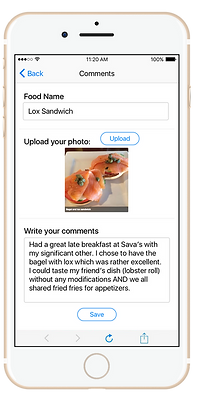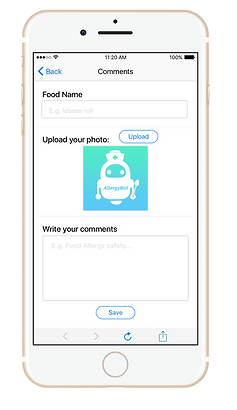THE DESIGN PROCESS

CHI 2017: AllergyBot
- Explore. Innovate. Inspire. -
In a team of 5, we decided to tackle the CHI 2017 Student Design Competition, whose challenge this year was to "create an intervention to “Level the Playing Field” in some fashion." Our team found that, for young adults with fatal food allergies, the fear of getting a reaction when dining out impairs their social aspect of life, and the exhausting process of searching and communicating also increase their anxiety.
Hence, to improve the quality of life, through funnel research method and iterative human-centered design approach, our team came up with AllergyBot, an intelligent and humane Chatbot that provides restaurants allergy accommodation information based on users’ allergens as a form of conversation in established instant messaging platforms that young adults are familiar with. AllergyBot aims to reduce the users’ inquiry overload, improve their overall dining out experience, and support their social life.
It is estimated that up to 15 million Americans have food allergies, and the number is growing fast. In fact, Food Allergy Research & Education (FARE) has reported that 1 in every 13 children is affected by this potential deadly disease. Furthermore, a study has shown that food allergies among children increased approximately 50% between 1997 and 2011, which means more young adults will suffer from food allergy in the near future. Allergic reaction is life threatening—even small amounts of food allergens will cause a reaction, which can be attributed to a form of mislabeling or cross contact during food preparation.
The result of our survey shows restaurant/dining out is regarded as a circumstance under which food allergy causes inconvenience by the most respondents (91.3%). 70.6% of them feel food allergy influences their social life. According to one expert, food allergy is different from other chronic disease, like diabetes, which can be monitored and controlled. Allergy patients’ challenge is exposure. The feeling of uncertainty makes them anxious and leads to problems including social isolation. Moreover, all 3 experts said that for young adults, social need is more obvious than other age groups.
Therefore, we started our design process by asking:
"Is it possible to design something that could levitate the daily struggles for young adults with food allergies and improve their quality of life?"
Survey & Expert Interviews
Literature Review


To better understand food allergies and their impact on our users, we conducted literature review through various journals, online articles, and research papers.
Quality of Life Issues
Research has demonstrated that individuals with food allergies may experience impaired quality of life through elevated anxiety, stress, or social isolation. Young adults with food allergies indicated higher anxiety level than non-allergic adults. Young adults are also the group at highest risk for fatal allergic reactions. The expected attributable social and emotional contributing factors include risk-taking behavior with eating.
Risks of Dining-out
Restaurants and non-commercial food services establishments are found responsible for most of the food allergic reactions, due to cross-contact, hidden allergens, miscommunication between wait staff and cooks, ingredients not being declared at restaurants, and skin contact with food residuals. Deaths caused by food-induced anaphylactic reactions are increasing, with most caused by food purchased outside the home. In fact, a recent study shows that more than 10 percent of the servers, food workers and restaurant managers reported the false and hazardous belief that customers with food allergy can safely eat small amounts of the food to which they’re allergic


-
Food detecting devices: Allergy Amulet is a portable and food allergen and ingredient detection device. For users who have several allergies, they need to buy several devices.
-
Restaurants recommendation platform: AllergyEats helps people with food allergies to find restaurants. However, the number of reviews is limited.
-
Legislation: it would be ideal to enact laws to improve food allergy awareness in restaurants, but implementation is difficult.

With our user findings and pain points, as a group we brainstormed several ideas, including:
-
A real-life survival and scheduling game that educates young adults to avoid risks in real life.
-
An allergy-educated restaurants recommended mobile app.
-
A plug-in built in messaging tools that help users communicate their allergy concerns with friends.
-
A Groupon-like platform where restaurants can market their allergy-educated service.
Wireframing & Prototyping
Interactive Video
Final Screens

We hope that AllergyBot could serve as a platform for our target users to explore dining options without inquiry overload and hectic preparations, to innovate new social changes in interacting with others, and to inspire corporations to recognize the importance of tending to their needs.
Solution At a Glance:
We first conducted user survey with 168 food allergies individuals and interviewed 3 food-allergy experts, including health professional, nutritionist, and allergy advocate.on.

2. The Landscape
Competitive Analysis
3. The Users
Our findings in literature review led us to focus on young adults and further interview 5 users to learn the inconvenience of dining out and social life. All interviewees reported that dining out is risky and challenging, and hence the process of preparations beforehand is necessary but time-consuming, one interviewee even reported to spend a minimum of 2 hours to check a restaurant before dining out.
Realizing that restaurant is an important stakeholder, we also interviewed 20 restaurants to try to involve them. However, most of these restaurants had great confidence in their ability to provide food allergy-educated services.
These findings contradicted with the feelings of our experts and user interviewees, who regard that some restaurants’ confidence may come from their lack of knowledge in food allergy. In addition, restaurants that are not allergy-educated did not show any interest in improvement.
4. Ideation & Paper Prototype

The ”Ah-Ha” Moment
After user interviews, we have created personas to help us narrow down our design functions. Our target users have the following characteristics:
-
They are exhausted by the complex searching process of finding allergy-educated restaurants.
-
They are familiar with instant messaging platforms.
-
They do not want to cause inconvenience for their friends.
Brainstorming


We settle on the idea that best fits our users--AllergyBot, a Chatbot technology, aims to assist young adults with food allergies to find information about restaurants’ accommodation. This bot is built in existing instant messaging apps or platforms such as Messenger and use existing restaurants APIs. It allows users to access information conveniently in an automatic and familiar manner. They can check a restaurant quickly and tell their friends their concern during their conversation naturally, thus reducing the inquiry workload and the sense of “a burden to others”.
Key Features:
-
Create and share personal allergy information
-
Check a restaurant and see allergy-free menus
-
Encourage users to contribute reviews
-
Become smarter with the increasing interaction with users
5. Testing


We recruited 6 participants to test low-fidelity paper prototype with tasks and asked for feedbacks.
Findings From User Testing:
-
Users liked AllergyBot for they felt like they were chatting with a friend.
-
They hoped to have additional functions, like allergy-free menu and prices of restaurants, allergy related reviews based their specific type of allergy, and a button to bookmark or save the restaurants they are interested in.
-
Users were confused about when and how they will be reminded to write a review.
-
Users wanted shorter text and hoped to tap the restaurant image to see basic information.
6. The Final Design Solution
After testing with paper prototypes and final interaction changes has been made, we built final design using Sketch. Once the screens are ready, the interactions were made using Principle. Then, to illustrate how the Chatbot works, interactions are show with a video.








7. The Future
NOTE: The CHI student design competition received 70 submissions around the world, and had a 17% acceptance rate. Our team submitted one of the top 12 entries.
1. The Problem
0. The Motivation



Information Disconnect


